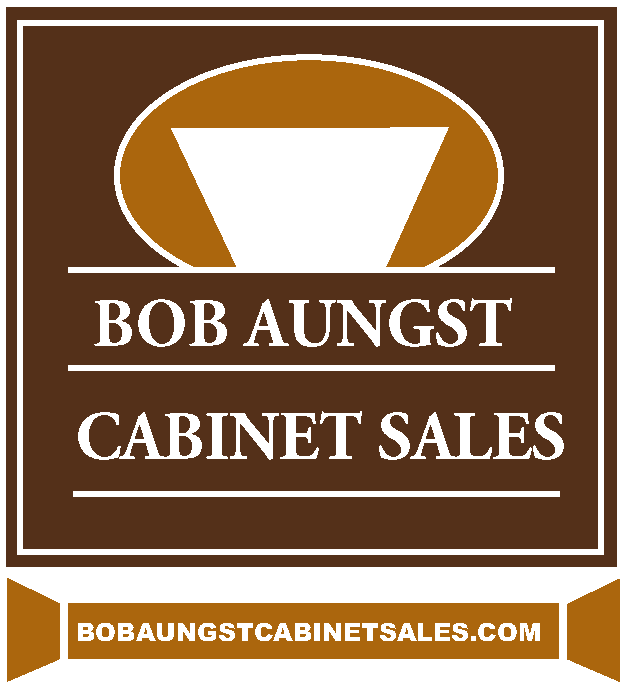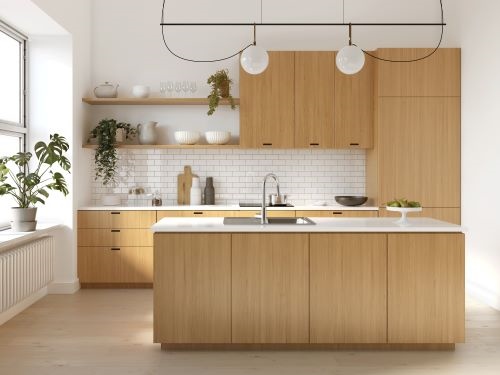Homeowners who are planning a kitchen renovation have usually heard of the “work triangle”. They have at least some knowledge of the traditional three-leg approach to the kitchen layout. The work triangle is the distance between sink, range and fridge. This work triangle has been the standard for kitchen layouts for decades.
The NKBA established the standards for the kitchen work triangle. This occurred back when kitchens had only one sink, appliance, island, chef helper and cook. The work triangle dictates:
- No leg of the triangle should be less than 4 feet or more than 9 feet
- The totally distance of the three sides should not exceed 26 feet
- No traffic should cut thru the triangle
- The triangle should not cut across an island
The concept of the kitchen triangle served as a great guide when kitchens were small. But times have changed and so have kitchen designs. While some version of the working triangle can be used because of its efficiency, today’s kitchen designers have more flexibility.
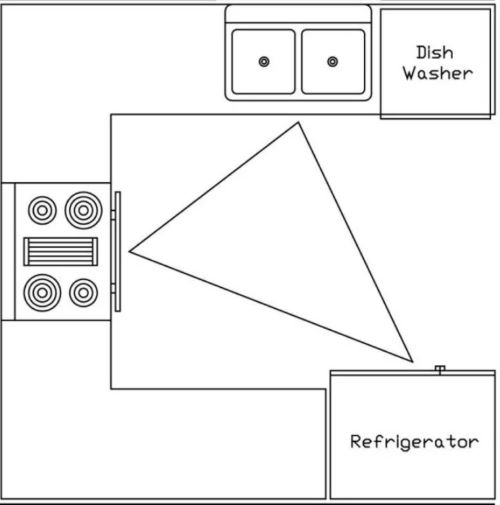
The Work Trapezoid Instead of the Work Triangle
The primary function of any kitchen will always be to prepare and cook food. And yet, today’s kitchens have evolved into a multi-tasking space. Islands and breakfast nooks now function as places to do homework, pay bills, play games, participate in work meetings via zoom. These activities are all in addition to preparing and eating meals and entertaining.
Houzz reports that multi-zone kitchens designed with a work trapezoid, rather than the traditional kitchen work triangle, includes dedicated areas – or zones — for baking, prepping and chopping, clean up, for snacks, drinks or homework.
Importance of Kitchen Layout
When beginning the design process, as a kitchen pro, you must take into consideration kitchen workflow. Further, the way in which the various work zones interact with each other is just as important as what happens in the zone itself. Cooking, clean up, entertaining, kids, holidays and zoom meetings must all be considered.
Kitchen designers have discovered that the key to designing an efficient multi-tasking, multi-zone kitchen space is getting the layout right — before picking styles and colors.
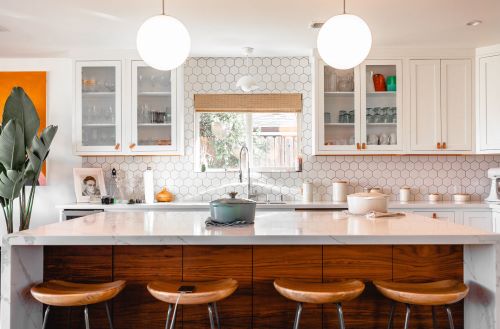
What's Changed?
Today’s casual lifestyle has become the way most people live and entertain. The kitchen is now a place for a busy family to congregate. A place where everyone has two things going at once, dinner guests “help” prepare a meal or extended family and friends drop by for a visit or morning coffee. The kitchen is no longer a closed off room where the cook works over a hot stove while the family or guests are socializing somewhere out of her sight, probably in the “family room” or den.

Most of today’s kitchens aren’t limited to the three working points of the kitchen work triangle. Further, they’re not limited to a single cook or even a single generation. Many more households are multi-generational today – nearly 20% of the US population lives with three or more generations in the home, according to Pew Research, up from 12% in 1980.
The Kitchen Work Triangle Still Works
The classic work triangle is still relevant, especially for smaller kitchens where there isn’t enough space for work zones.
The kitchen work triangle continues as the basis of many kitchen layouts. However, it has morphed and changed to accommodate larger kitchens. Kitchen designers had to come up with innovative solutions to improve the work flow and make sure kitchen activities were easy and efficient. Thus, the zone concept was born.
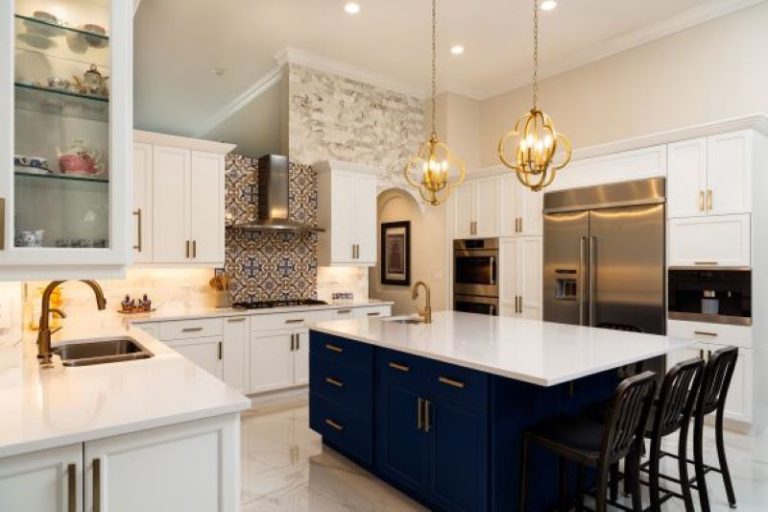
Kitchen layouts now may include two or more triangles or at least a few more legs to the work triangle. This is especially true in large kitchens where multiple cooks work at multiple sinks, cooking stations and prep areas.
The Impact of the Open-concept Floor Plan
The open-concept floor plan brought about the idea of congregating in the kitchen, an area once considered “off limits” to family and guests when the cook was at work. Then homeowners wanted larger kitchens because the traditional dining room was typically done away with and they needed somewhere to eat.
To get the most use from the kitchen, designers had to create layouts with zones in which to work, cook and spend time with family and friends. They eliminated separating walls and integrated the living room and/or dining area into their kitchen designs. This way, homeowners can cook and socialize, all in one open space.
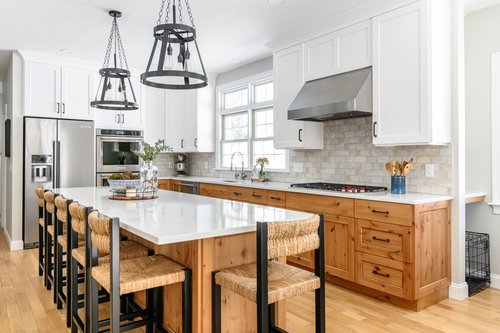
The Work Zones
“Zoning” is the term designers are using to describe the layout of a kitchen according to the way the homeowners use it. For example, the kitchen island gets used beyond being a place for food preparation. During the day it can be used as a place to set up a laptop for WFH (work from home), homework after school and food prep, then dining in the evening. Further, the chef and/or chefs need a dedicated work zone out of the way of other household members and guests when they are preparing a meal.
Organizing the kitchen into zones also makes tasks more manageable. Ask your client to think about all the different tasks they perform in the kitchen. Then it’s your job to plan the layout so everything needed for that task is grouped together.
Five main zones make up today’s kitchens.
- Perishable food storage, including the fridge and freezer
- Dry food storage in a pantry
- Prep space with working surfaces
- A cooking zone that includes the oven, cooktop and/or range
- Wet zone for clean-up, i.e., sink(s) and dishwasher(s)
Larger kitchens may also include a sixth zone for entertaining that allows family and friends to gather and be with the cook while out of his or her way.
Conclusion
Good kitchen design should be both beautiful and functional, while catering to the client’s needs. It’s a designer’s job to share the pros and cons of appliance, island and plumbing layouts to develop the best solutions, whether using the classic kitchen work triangle or its spin-off, the work zones, depending on the space.
Bob Aungst Cabinet Sales is a full-service rep agency with the goal of matching kitchen designers and remodelers with the cabinet manufacturers best suited to their business’ style and clientele. Owner Bob Aungst III represents Brighton Cabinetry, US Cabinet Depot, Integrity Cabinets and StyleCraft Luxury Custom Cabinets.
